|
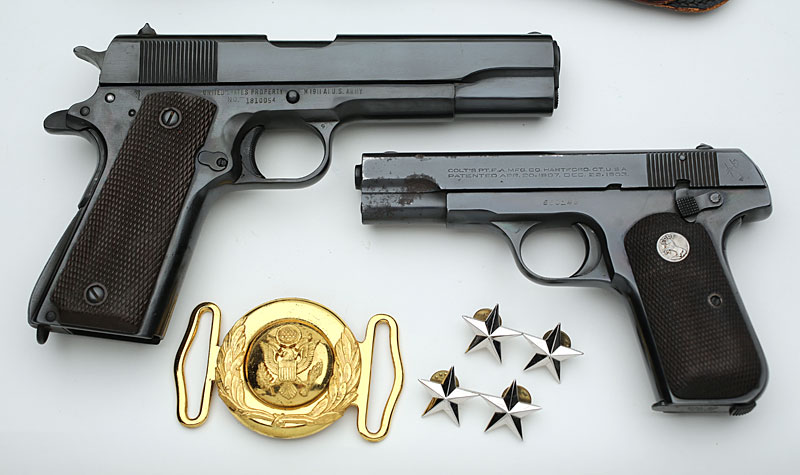
Colt Model 1903 Pocket Hammerless .32 ACP pistol serial
number 560148 and Remington Rand M1911A1 serial number
1810054 .45 ACP pistols - issued to
Major
General William Smith Coleman, U.S. Army - His Colt 1903
Pocket Hammerless .32 ACP General Officer's pistol was
issued to him on October 1, 1966. Both of these
pistols were carried by Major General Coleman during his
tours in Vietnam.
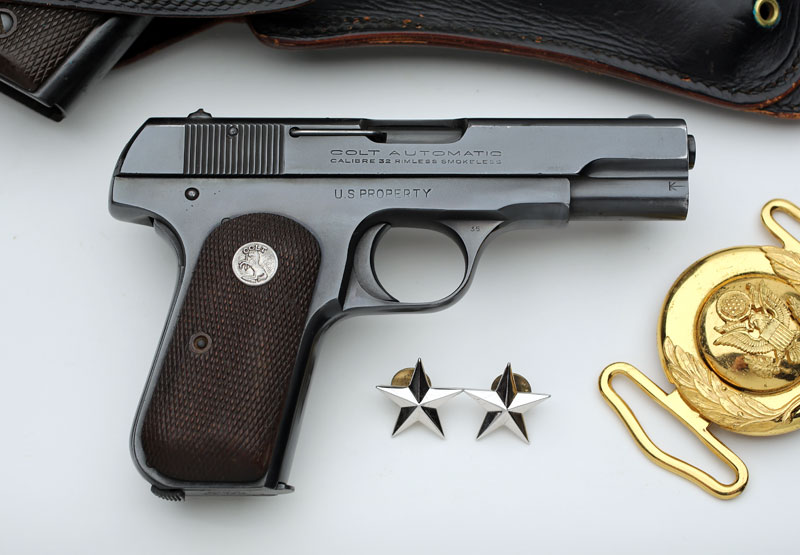
Colt Model 1903 Pocket Hammerless .32 ACP pistol serial
number 560148 - Right side.
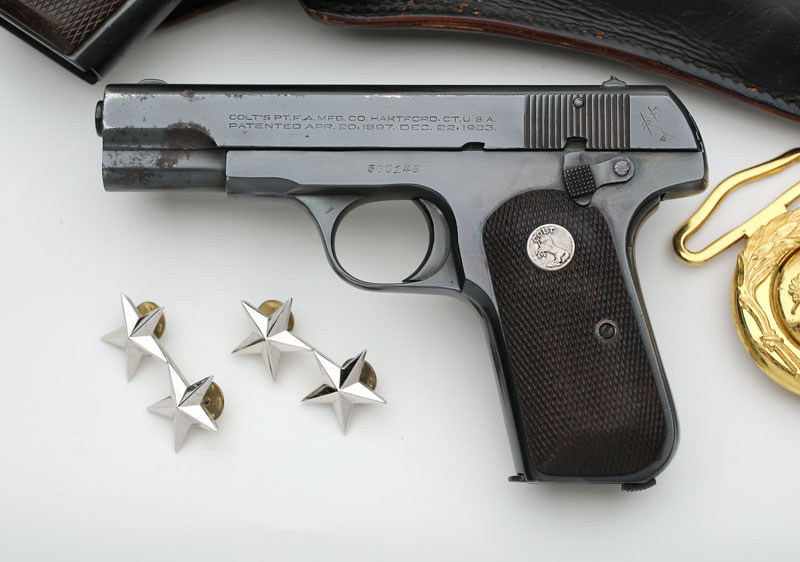
Colt Model 1903 Pocket Hammerless .32 ACP pistol serial
number 560148 - Left side close-up of ordnance mark.
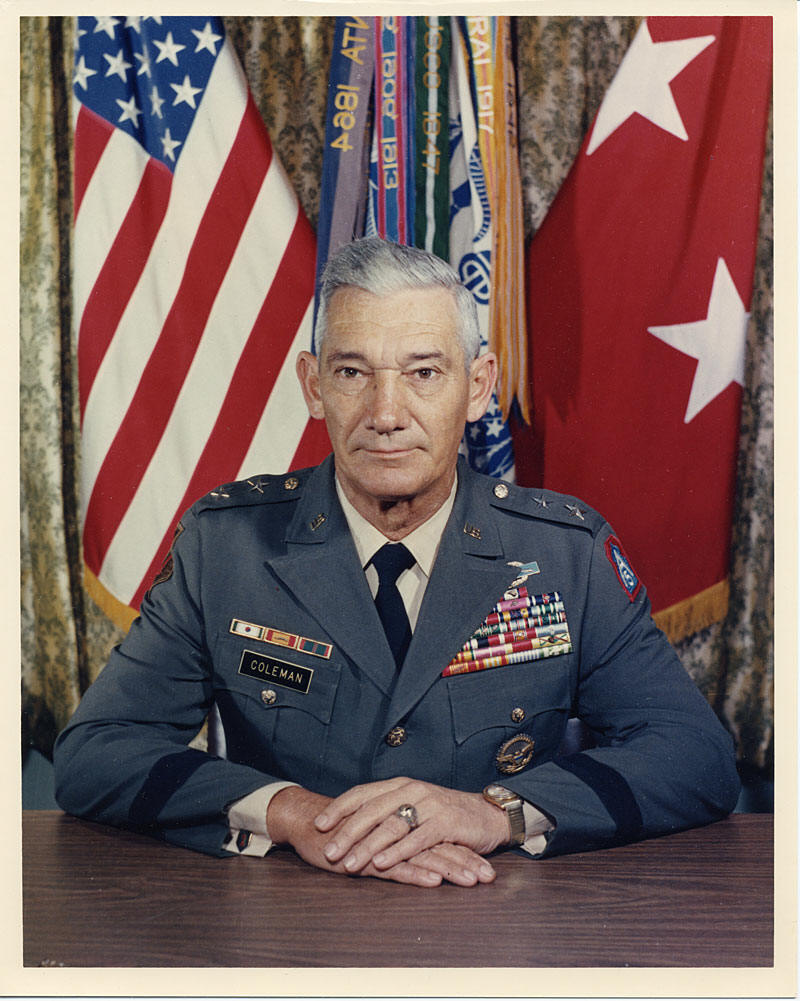
Major General William S. Coleman, Commander 6th
Readiness Region, 7 June 73 [3-C-357-1/AH-73
Fort Knox, Kentucky, Photo by Mrs. Maria
Albertson] |
Major General William S. Coleman, U.S. Army
(Active Service 1942 to 1974) |
|
Born 29 January 1919 |
|
Iva, South Carolina |
|
1939 |
|
Graduate, Clemson A&M
College, South Carolina |
|
1940 |
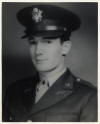 |
Commissioned 2LT, Infantry
– Reserve |
|
Aug 1939 to Feb 1942 |
|
Public High School Teacher,
McCormick, SC |
|
Mar 1942 |
|
Ordered to Active Duty |
|
Mar 1942 – Feb 1943 |
|
Infantry Replacement
Center, Camp Wheeler, GA:
Platoon Leader, and Company
Commander. |
|
Mar 1943 –May 1944 |
Participation in
Tunisian and Rome-Arno campaigns. |
North African Theater of
Operations, Eastern Base Section:
Company Commander. |
|
June 1944 – June 1945 |
Participation in
Rhineland, Southern France, and Central Europe
campaigns. |
Office of Strategic
Services (OSS), with Seventh Army,
Europe: Special Operations
Officer, Intelligence Officer. |
|
1945 – 1949 |
|
Camp Gordon, Georgia
(1945-48):
Company Cdr, Post Adjutant.
Fort Benning, Georgia:
Graduate, Infantry Officer Advanced Course
(1949) |
|
Oct 1949 – Aug 1951
|
Involved in withdrawal
to and defense of Pusan Perimeter, the
subsequent pursuit to the north, the initial
encounter with the Chinese in Oct 1950, the
withdrawal to South Korea and subsequent
counterattacks. |
1st Cavalry Division,
Japan (Oct 49 to Jun 50) and Korea (Jun
50 to Aug 51): S-3 and Executive
Officer, 1st Bn, 8th Cav Reg’t (Oct
49 to Sep 50);
S-3 and Executive
Officer, 8th Cav Regiment (Sep-Nov 1950);
Battalion Commander, 2nd
Bn, 8th Cav Regiment (Dec 50-Aug51). |
|
1951 through 1963 |
|
Graduate, Command and
General Staff College (1951). Instructor, Infantry
School, Fort Benning, Georgia (1951-1955).
Senior Army Advisor to
Alaska National Guard (1955-1957).Office of Secretariat,
Joint Chiefs of Staff, Washington D.C.
(1957-1959). Graduate, Army War College (1960);
Staff Officer, Pacific Command, Hawaii
(1960-63). |
|
1963-1965 |
|
1st Armored
Division, Fort Hood, Texas: Brigade Commander,
1963-1964.
Chief of Staff, 1964-1965. |
|
1965-1967 |
|
Faculty, Army War College |
|
June 1967 to May 1968 |
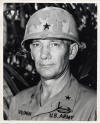
 |
First Infantry Division
(Big red One),
South Vietnam: Assistant Division
Commander |
|
May 1968 to Sep 1968 |
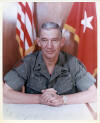 |
MAC-V, Saigon: Deputy J-3 |
|
Sep 1968 to Dec 1968 |
Re-assigned from MAC-V
to 1st Infantry Division after the CG of the 1st ID (MG
Keith Ware) was KIA on 13 Sep 1968 |
First Infantry Division,
South Vietnam: Assistant Division
Commander |
|
1969 to 1972 |
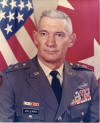 |
Fort Jackson, SC: Deputy Commanding General
(1969-1970);
Commanding General
(1970-1972). |
|
1972 to 1973 |
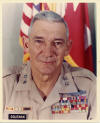 |
MAC-V, Saigon: Chief, Army Advisory
Group |
|
1973 to 1974 |
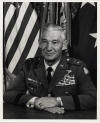 |
US Army Readiness Region
VI, Fort Knox, KY: Commanding General |
|
31 Aug 1974 |

 |
Retired |
|
25 Jul 1977 |
|
Death. Burial at Lebanon
Baptist Church, Anderson, SC |
|
Bold Face
signifies combat zone assignments. |
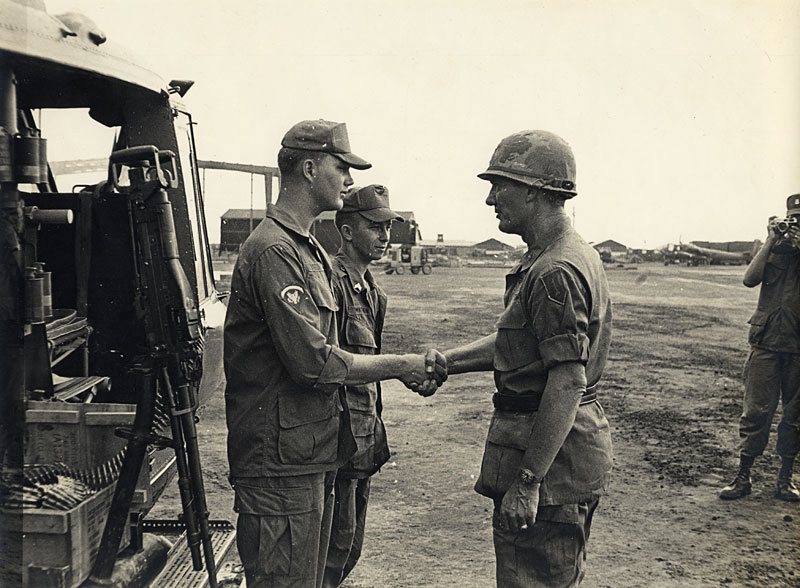
Brigadier General William S. Coleman and his Helo Crew.
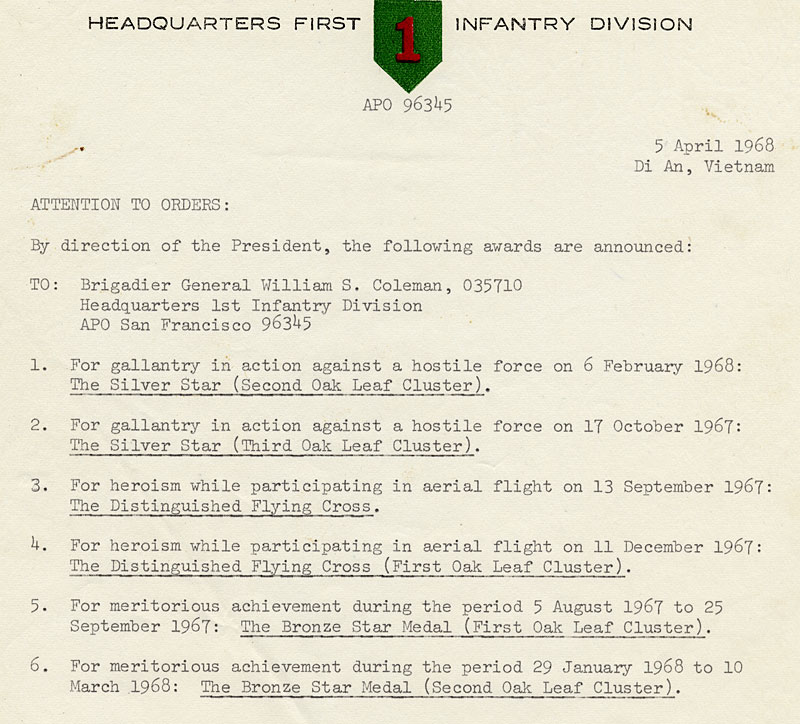
ATTENTION TO ORDERS - Documenting the award of two Silver
Stars, two Distinguished Flying Crosses and two Bronze Star
Medals to Brigadier General William S. Coleman, Di An,
Vietnam, 5 April 1968.
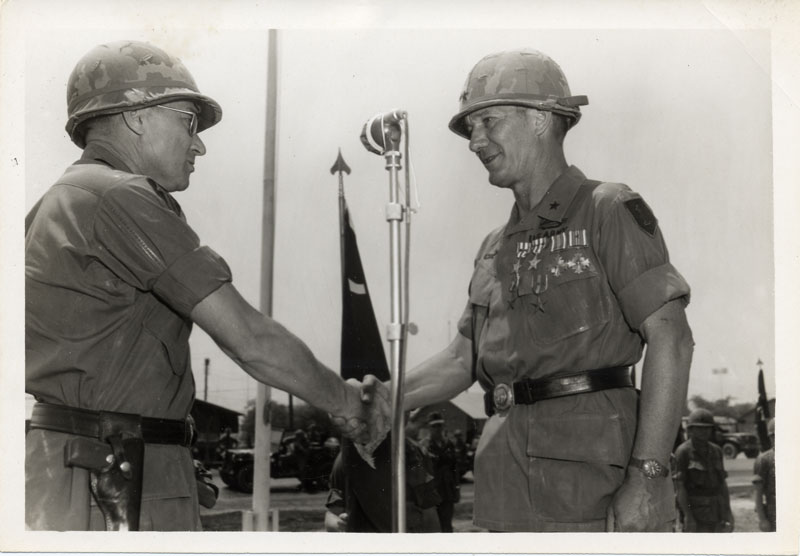
Major General Keith Ware, Medal of Honor recipient, presents Brigadier General William
S. Coleman with awards. [121-SIG-0202-4/ACA 6 OFFICIAL U.S.
ARMY PHOTO BY: 121ST SIG BN. 1ST INF DIV]
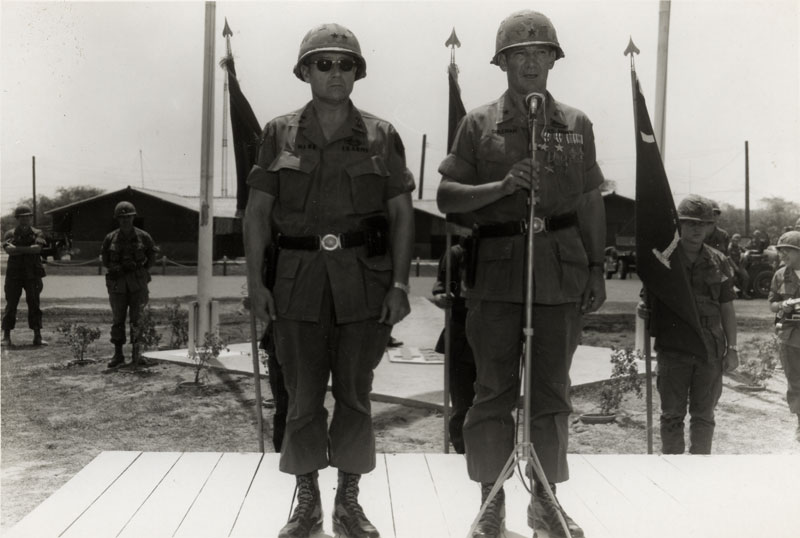
Major General Keith Ware (left) and Brigadier General
William S. Coleman (right). Brigadier General Coleman
addresses those in attendance following the presentation of
awards by MG Ware. [121-SIG-0202-3/ACA 6 OFFICIAL U.S. ARMY
PHOTO BY: 121ST SIG BN. 1ST INF DIV]
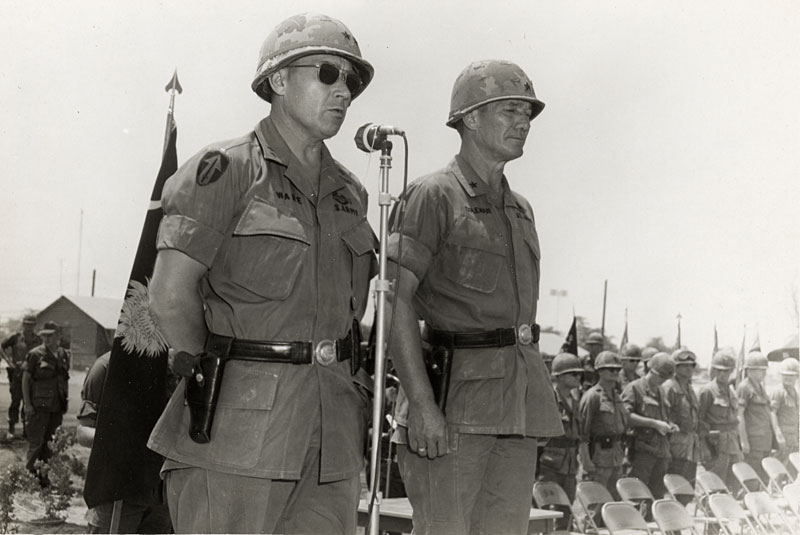
Major General Keith Ware (left) and Brigadier General
William S. Coleman (right). Major General Ware
addresses those in attendance following the presentation of
awards by MG Ware. [121-SIG-0202-10/ACA 6 OFFICIAL U.S. ARMY
PHOTO BY: 121ST SIG BN. 1ST INF DIV]
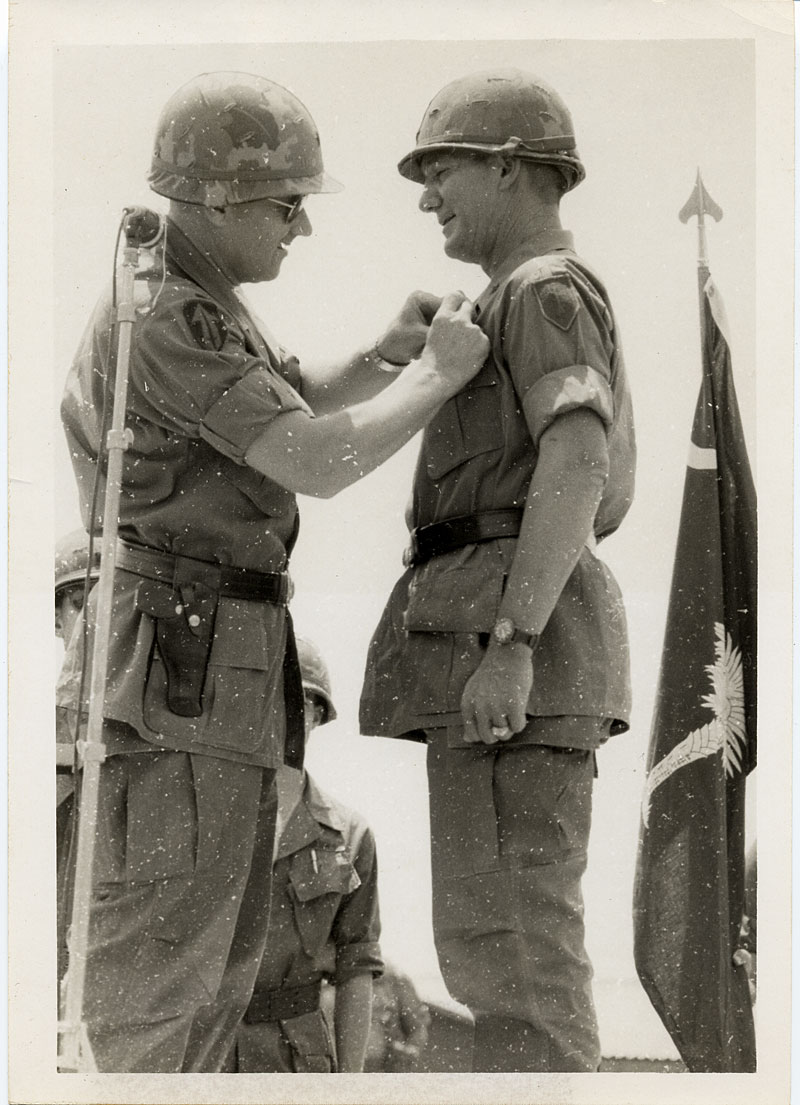
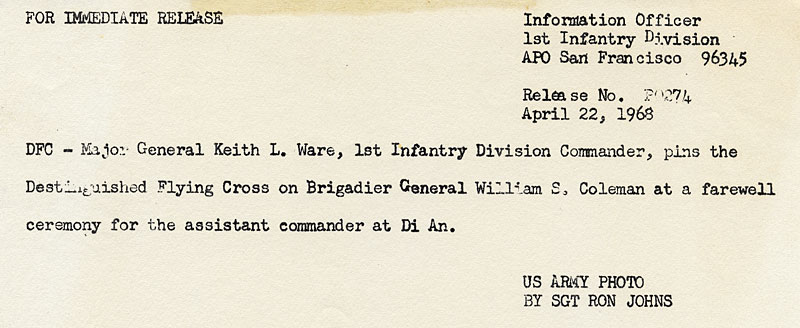
FOR IMMEDIATE RELEASE - April 22, 1968 -
DFC -- Major General Keith L. Ware, 1st Infantry Division
Commander, pins the Distinguished Flying Cross on Brigadier
General William S. Coleman at a farewell ceremony for the
assistant commander at Di An. (US Army Photo by Sgt Ron
Johns.)
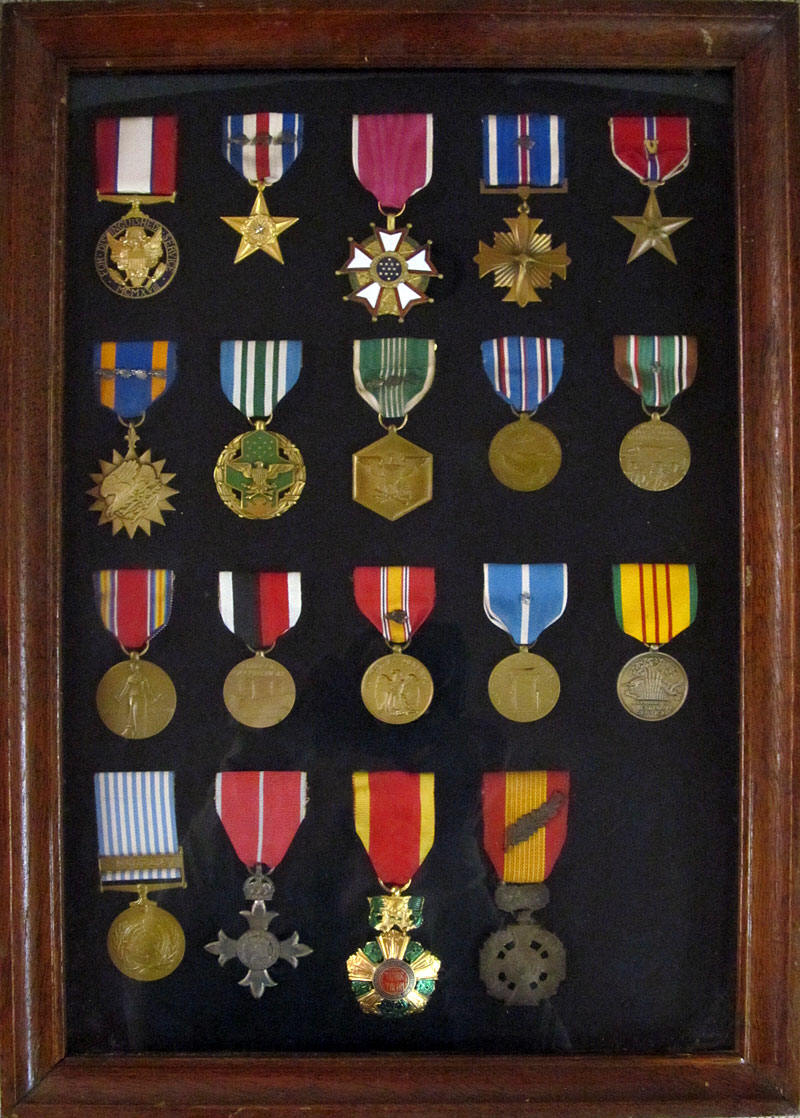
Citations and Decorations
- Distinguished Service Medal with two Oak
Leaf Clusters
- Silver Star with three Oak Leaf Clusters
- Legion of Merit with one Oak Leaf Cluster
- Distinguished Flying Cross with Oak Leaf
Cluster
- Bronze Star Medal with "V" Device
- Air Medal with thirty-eight Oak Leaf
Clusters with "V" Device
- Joint Service Commendation Medal
- Army Commendation Medal with three Oak Leaf
Clusters
- American Campaign Medal
- European-African-Middle Eastern Campaign
Medal with five campaigns and arrowhead
- World War II Victory Medal
- Army of Occupation Medal (Germany)
|
- National defense Service Medal with one Oak
Leaf Cluster
- Korean Service Medal with five campaigns
- Vietnam Service Medal with five campaigns
- Order of British Empire (Honorary Member)
- Republic of Vietnam National Order Fourth
Class
- Republic of Vietnam National Order Fifth
Class
- Vietnamese Cross of Gallantry with Palm
- Republic of Vietnam Armed Forces Honor Medal
First Class
- United Nations Service Medal
- Republic of Vietnam Campaign Medal
- Presidential Unit Citation (Republic of
Korea)
- Unit Award - Gallantry Cross with Palm
- Combat Infantryman's Badge
|
Major General William S. Coleman, USA
(29 January 1919 - 25 July 1977)
Obituary of MG William Coleman from
The State newspaper, Columbia, SC, July 26, 1977:Former Ft. Jackson
Commander, Gen. W. S. Coleman Dies
Maj. Gen William S. Coleman, who served
as Ft. Jackson commanding general from July 1970 to May
1972, died Monday at Moncrief Army Hospital after a long
illness. He was 58.While serving as the 26th
commanding general of Fort Jackson, he saw modernization of
the fort, including the new hospital he called “the most
modern in the Southeast” in terms of equipment and overall
design.
Gen. Coleman, an Iva native, was reared in Anderson. He was a 1939
graduate of Clemson College, receiving a commission as a second lieutenant of
Infantry through the ROTC program. He taught high school in
McCormick for a time after graduation, shortly thereafter assuming his initial
duties in the inactive reserves as an infantry unit commander at Camp Wheeler,
Ga. He then served some 15 months with the Eastern Base Section in North
Africa.Upon activation of the U.S. Seventh Army for the invasion of Southern France in
June 1944, Gen. Coleman was assigned to the Office of Strategic Services (OSS)
as special operations and intelligence officer with the Seventh Army
Headquarters until the end of World War II.
Following his return to the United
States in August 1945, Gen. Coleman served at Camp Gordon,
Ga., as a company commander and adjutant, and was integrated
into the Regular Army in July 1946.Gen. Coleman attended the Infantry
Officer Advanced Course at Ft. Benning, Ga., from
1948-1949. He then served for two years during the Korean
War with the 1st Cavalry Division during which time he was
assigned to the First Battalion S-3 and executive officer,
the regimental S-3 and executive officer, 8th Cavalry
Regiment, and commanded the 2nd Battalion.
During his service with the division,
the regiment was involved in the withdrawal to and defense
of the Pusan Perimeter, the subsequent pursuit to the north,
the initial encounter with the Chinese in October 1950, the
withdrawal to South Korea and subsequent counterattacks to
the north.He attended the Command and General
Staff College at Ft. Leavenworth, Kan., in 1951 and was for
three years an instructor in the Tactics Department of the
Infantry School at Ft. Benning, Ga.
His next assignment during 1955-57 was
as Senior Army Advisor to the Alaska National Guard in
Juneau, Alaska. Upon his return in July 1957, he served
with the Secretariat, Office of the Joint Chiefs of Staff,
Washington, prior to attending the Army War College,
Carlisle Barracks, Pennsylvania, graduating with the class
of 1960.He was then assigned to the Joint Staff
of the Pacific Command in Hawaii, where he served until 1963
in the General War Plans and Policy section of the Plans
Division.In August 1963 he assumed command of
the 2nd Brigade, 1st Armored Division (Old Ironsides) at Ft.
Hood, Tex., and then served for a year as Division Chief of
Staff until July 1965.
He was next assigned to the U.S. Army
Combat Developments Command Institute of Advanced Studies at
Carlisle Barracks, Pennsylvania, until joining the faculty
of the Army War College in June 1966 as Director of Course I
and International Relations Studies.Gen. Coleman served two tours of duty
in Vietnam during the period from 1965 to 1973. In his
first tour of duty there he served as the Assistant Division
Commander, 1st Infantry Division and later as Deputy
Assistant Chief of Staff, Plans and Operation, U.S. Military
Assistance Command.
The Commanding General, 1st Infantry
Division for that period, Lt. Gen. (then Maj. Gen.) Orwin
Talbott recently said of Gen. Coleman’s tour of duty with
the Division:“Of all the great soldiers I knew and
was associated with in Vietnam, there was not one I admired
more than Bill Coleman. I have many times referred to him
as being of pure gold. Nothing could be truer.”
During his second tour in Vietnam, Gen.
Coleman served as Chief, Army Advisory Group, USMACV.On January 6, 1969, Gen. Coleman became
the Deputy Commanding General of Fort Jackson, during which
time he was instrumental in making the fort one of the prime
training installations in the country for basic, advanced
infantry and combat support trainees. He assumed command of
the post on July 15, 1970.
He served as commanding general at Ft.
Jackson until July 2, 1972, when he transferred to the
Military Assistance Command in Vietnam.Gen. Coleman retired Sept. 1, 1974,
after more than 32 years service with the Army as commanding
general of the U.S. Army Readiness Region VI at Ft. Knox,
Ky., where he oversaw the transition from the old system of
local reserve unit advisors to the more sophisticated
Readiness Region concept.
He is a graduate of the Infantry
School, the Command and General Staff College, the Army War
College and was awarded a master’s degree in International
Affairs by George Washington University in 1966.His decorations include the
Distinguished Service Medal with two Oak Leaf Clusters, the
Silver Star with three Oak Leaf Clusters, the Legion of
Merit with one Oak Leaf Cluster, the Bronze Star Medal with
the “V” device, and the Air Medal with 38 Oak Leaf Clusters
with the “V” device.
Gen. Coleman is survived by his widow,
the former Ruth Ducworth of Anderson, and four children,
Susan Coleman Fedor, Nancy Coleman Hart, 2nd Lieutenant
William S. Coleman, Jr., and Mary Leon Coleman.Funeral plans will be announced and the
family will receive friends at Dunbar Funeral Home, Gervais
Street Chapel, tonight from 7 to 9 p.m.
The family suggests that those who may
wish may make memorials to the 1st Infantry Scholarship Fund
or a charity.Highest Awards and Decorations
- Distinguished Service Medal (with two
oak leaf clusters)
- Silver Star (with three oak leaf clusters)
1. TC320. The following AWARD is announced.COLEMAN, WILLIAM S. O35710 BRIGADIER GENERAL United States Army
Headquarters and Headquarters Company 1st Infantry Division
AWARD OF THE SILVER STAR
| Award: |
Silver Star (First Oak Leaf Cluster) |
| Date of action: |
31 October 1967 |
| Theater: |
Republic of Vietnam |
| Reason: |
For gallantry in action against a hostile force:
On this date, during Operation Shenandoah II,
General Coleman was flying in his command and
control helicopter over the embattled Special Forces
camp at Loc Ninh. The besieged camp was being
subjected to intensive mortar and rocket fire and
massive Viet Cong human wave assaults. In
spite of the extreme concentrated volume of
antiaircraft fire being directed against his
helicopter from several directions, General Coleman
remained over the battle site assessing the tactical
situation. With complete disregard for his
personal safety, he ordered his pilot to make low
level sweeps over the enemy forces so that he could
determine the location of hostile mortar and rocket
emplacements and troop concentrations. Ignoring the
constant danger from the hail of hostile ground
fire, General Coleman leaned precariously out of the
door of the aircraft in an effort to pinpoint the
insurgent positions. He observed that the
defensive bunkers, from which the Army of the
republic of Vietnam and Special Forces troops were
defending their position, were being subjected to
heavy Viet Cong rocket fire and rendered
ineffective. He then located the enemy rocket
emplacements and directed the fire of helicopter
gunships on them with devastating effectiveness.
Refusing to maneuver out of range of the Viet Cong
antiaircraft fire, General Coleman remained over the
embattled area during the entire conflict in order
to adjust highly accurate supporting artillery fire
onto the enemy force. This suppressive fire
enabled the friendly ground force to gain fire
superiority and repel the insurgent assaults.
His outstanding display of aggressiveness, courage
and leadership was responsible for inflicting heavy
losses in men and material upon the enemy force and
bringing about its overwhelming defeat.
Brigadier General Coleman's unquestionable valor
while engaged in military operations involving
conflict with an insurgent force is in keeping with
the finest traditions of the military service and
reflects great credit upon
himself, the 1st Infantry Division, and the United
States Army. |
| Authority: |
By direction of the President, under the
provisions of the Act of Congress, approved 9 July
1918. |
| Award: |
Silver Star (Second Oak Leaf Cluster) |
| Date of action: |
6 February 1968 |
| Theater: |
Republic of Vietnam |
| Reason: |
For gallantry in action against a hostile force:
On this date, Brigadier General Coleman was flying
in his command and control helicopter overwatching a
heavy engagement taking place on the ground between
a friendly mechanized infantry battalion and a Viet
Cong force. The acting division commander,
also in a command and control ship was below General
Coleman's ship. Suddenly, the Viet Cong opened
fire with heavy machineguns. General Coleman
immediately saw that the commanding general's ship
had been hit. The enemy fire had killed the
doorgunner and wounded a general staff officer
onboard. General Coleman realized that the
damage to the aircraft was of such magnitude that
the ship had lost the capability to take evasive
action. The enemy fire continued, trying to
find its mark against the floundering and smoking
aircraft. General Coleman brought his ship
down on the enemy gun position at low level with his
doorgunners delivering heavy suppressive fire.
The presentation of his ship as a target caused the
enemy to turn their fire on him. By repeated
low level passes and a continuation of heavy
suppressive fire by General Coleman, the commanding
general's aircraft was able to clear the embattled
area and glide safely to a forced landing in a
secure area. Assured of the safety of his
superior, General Coleman turned his attention to
destroying the enemy antiaircraft positions.
The Viet Cong had chosen an excellent firing
position in a draw that had no clearly identifiable
terrain feature by which aerial observers could
adjust fire. Consequently, General Coleman
remained at low level in order not to lose sight of
the location of the enemy weapons. He
personally directed the placement of artillery fire
and the fire of gunships, not leaving his vulnerable
position until devastating and effective firepower
had been repeatedly placed upon the insurgent
position. Had it not been for the daring,
immediate and aggressive action of General Coleman,
the acting commanding general's aircraft, in its
helpless situation, would have afforded an east
target for the enemy gun positions and undoubtedly
been lost. Brigadier General Coleman's
unquestionable valor while engaged in military
operations involving conflict with an insurgent
force is in keeping with the finest traditions of
the military service and reflects great credit upon
himself, the 1st Infantry Division, and the United
States Army. Brigadier General Coleman's gallantry in action
was in keeping with the highest traditions of the
military service and reflect great credit upon
himself, the 1st Infantry Division, and the United
States Army. |
| Authority: |
By direction of the President, under the
provisions of the Act of Congress, approved 9 July
1918. |
| Award: |
Silver Star (Third Oak Leaf Cluster) |
| Date of action: |
17 October 1967 |
| Theater: |
Republic of Vietnam |
| Reason: |
For gallantry in action while
engaged in military operations involving conflict
with an armed hostile force in the Republic of
Vietnam: Brigadier General Coleman
distinguished himself by exceptionally valorous
actions in 17 October 1967 while supporting troops
of his division during a search and destroy
operation in enemy territory. As the friendly
force moved into a densely foliated area it was
subjected to intense grenade, small arms and
automatic weapons fire by a numerically superior
combined force of Viet Cong and North Vietnamese
Regulars. General Coleman immediately flew to
the battle area in his command and control
helicopter. Due to the dense foliage, his
visibility of the ground action was extremely
limited. With complete disregard for his
personal safety, he ordered his pilot to fly at
treetop level, fully exposed to the enemy fire.
He quickly located the friendly and hostile
positions and directed the defenders' firepower on
the assaulting insurgents. He realized that an
acute need for medical supplies for the wounded had
developed and flew to a nearby fire support base,
picked up medical supplies and quickly returned to
the beleaguered force. There was only one
suitable drop zone in the area, and it was necessary
for the aircraft to hover approximately fifty feet
above the ground while the supplies were dropped.
Enemy fire directed at the aircraft increased, but
general Coleman remained in the vulnerable position
until the drop had been successfully accomplished.
Continuing his mission, General Coleman sighted
twenty to thirty soldiers who had been cut off from
the main element and were threatened by friendly
artillery and the Viet Cong. Without
communication, he directed his aircraft low over the
men and successfully guided them towards the main
force's defensive position. Remaining low and
still receiving enemy fire, he adjusted artillery
and air strikes against the insurgents with
devastating effectiveness and successfully repelled
their repeated attempts to overrun the friendly
force. He then landed, regrouped his men and
directed the evacuation of causalities.
Brigadier General Coleman's gallantry in action was
in keeping with the highest traditions of the
military service and reflect great credit upon
himself, the 1st Infantry Division, and the United
States Army. |
| Authority: |
By direction of the President, under
the provisions of the Act of Congress, approved 9
July 1918. |
- Legion of Merit (with one oak leaf cluster)
- Distinguished Flying Cross (with one oak leaf cluster)
AWARD OF THE DISTINGUISHED FLYING CROSS
1. TC320. The following AWARD is announced.COLEMAN, WILLIAM S. O35710 BRIGADIER GENERAL United States Army
Headquarters and Headquarters Company 1st Infantry Division
| Award: |
Distinguished Flying Cross |
| Date of action: |
13 September 1967 |
| Theater: |
Republic of Vietnam |
| Reason: |
For heroism while participating in
aerial flights: On this date, Brigadier
General Coleman was flying in his command and
control helicopter over the village of Chanh Luu,
which had been determined to be the base of
operations of a large Viet Cong force. As
Friendly ground forces were sealing the enemy
village, General Coleman spotted a number of
insurgents escaping through a sector which had not
yet been sealed. Disregarding his personal
safety, he ordered his pilot to make low level
sweeps over the embattled area as he directed his
door gunner's fire onto the insurgents.
Remaining over the hazardous area, he guided
friendly ground forces to the enemy position where
they found two dead and three wounded Viet Cong and
documents which proved to be of great intelligence
value. General Coleman then resumed his low
level passes over the enemy village, marking its
location for helicopter gunships and enabling them
to place devastating fire upon the insurgent
stronghold. His skillful leadership and high
degree of professionalism contributed immeasurably
to the successful sealing of the Viet Cong infested
village with a minimum of danger to the friendly
ground forces. Brigadier General Coleman's
actions are in keeping with the finest traditions of
the military service and reflect great credit upon
himself, the 1st Infantry Division, and the United
States Army. |
| Authority: |
By direction of the President, under
the provisions of the Act of Congress, approved 2
July 1926. |
| Award: |
Distinguished Flying Cross (First
Oak Leaf Cluster) |
| Date of action: |
11 December 1967 |
| Theater: |
Republic of Vietnam |
| Reason: |
For heroism while participating in
aerial flights: On this date, Brigadier
General Coleman was serving as assistant division
commander of the 1st Infantry Division. He was
making an aerial reconnaissance by helicopter of the
area surrounding Song Be, recently established as
the operations sector of one of the division's
battalions. The hilly terrain necessitated
that the aircraft make continuous low passes in
order for General Coleman to obtain the surveillance
desired. On one such pass the craft was
subjected to an intensive burst of automatic weapons
fire. General Coleman immediately ordered his
pilot to take evasive actions. However, he had
the aircraft remain at a low and vulnerable level so
that he could keep the source of the hostile
weapons' flash accurately located. General
Coleman then guided an aerial observer to the
target, but the artillery rounds fired were only
partially effective. With complete disregard
for his personal safety, he then had his aircraft
fly at a vulnerable altitude, fully exposed to the
enemy position, and he adjusted the artillery until
maximum effective fire was placed on the target.
Throughout this entire period, the general's craft
remained at a low level so that he could insure that
no insurgents escaped the devastating fire.
The outstanding courage and aggressiveness displayed
by General Coleman during extreme peril were an
inspiration to his men and directly responsible for
the annihilation of the enemy position.
Brigadier General Coleman's actions are in keeping
with the finest traditions of the military service
and reflect great credit upon himself, the 1st
Infantry Division, and the United States Army. |
| Authority: |
By direction of the President, under
the provisions of the Act of Congress, approved 2
July 1926. |
|